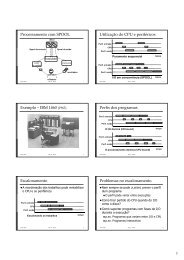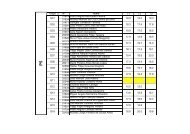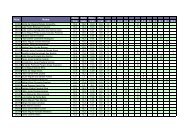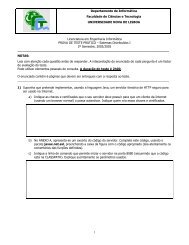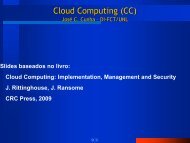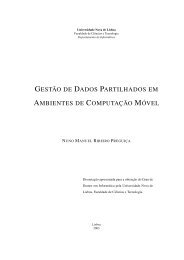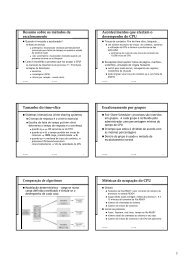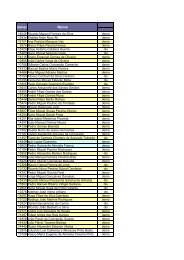Dissertaç ˜ao de Mestrado Mestrado em Engenharia Informática Jo ...
Dissertaç ˜ao de Mestrado Mestrado em Engenharia Informática Jo ...
Dissertaç ˜ao de Mestrado Mestrado em Engenharia Informática Jo ...
Create successful ePaper yourself
Turn your PDF publications into a flip-book with our unique Google optimized e-Paper software.
Summary<br />
Among the information technology sectors is the virtualization sector, which stands out by<br />
being a very active area, with many collaborations and advances. Virtualization’s benefits are<br />
plenty. Some of th<strong>em</strong> are the massive server consolidation, reduced cooling, structural and<br />
electrical costs and the isolation between virtual machines.<br />
Virtual appliance is a concept resulting from the advanc<strong>em</strong>ents on virtualization, and <strong>de</strong>-<br />
fines an alternative software distribution mo<strong>de</strong>l from those existing by then, such as the tradi-<br />
tional CD-ROM distribution, software as a service and hardware appliances. This mo<strong>de</strong>l allows<br />
customers to have their IT solution fully specified and optimized for the task it must perform.<br />
With the virtual appliance outbreak, many servers using different applications tend to<br />
gather on the same physical machine. The applications, in turn, may impl<strong>em</strong>ent plenty config-<br />
uration formats, from wi<strong>de</strong>ly adopted standards to proprietary formats. The configuration of<br />
these applications is typically carried by busy syst<strong>em</strong> administrators, who must <strong>de</strong>dicate some<br />
of their time coping such a vast configuration format range.<br />
This thesis contributes for the nourishing of the virtual appliance concept and proposes<br />
the creation of a tool which automatically configures applications insi<strong>de</strong> virtual appliances,<br />
regardless of the application being configured. The contributions on this area are, therefore,<br />
very rare, which elevates this dissertation to a pioneer of the area.<br />
The approach for the probl<strong>em</strong> of automatic application configuration explores the frequently<br />
found patterns in configuration files. Typically, those files use similar concepts, such as parame-<br />
ter <strong>de</strong>finitions, parameter blocks and comments. Besi<strong>de</strong>s this, only some files were found to im-<br />
pl<strong>em</strong>ent other concepts, although on a punctual basis. This dissertation proposes a framework<br />
for the automatic configuration of applications based on this characteristic. A configuration<br />
file is transformed to a structured and application-in<strong>de</strong>pen<strong>de</strong>nt language, like the eXten<strong>de</strong>d<br />
Markup Language, which is then modified and reverted to its original syntax.<br />
Keywords: Virtual appliance, automatic application configuration<br />
vii



